| This
is a combination kit/magazine made by IBG Models (Poland) and Guideline
Publications (UK) as part of their "The World at War" line.
The 1/72 kit comes with a full-sized 20 page color magazine; you can
actually purchase an annual subscription and receive ten kit/magazines.
The kit comes in a one-piece box with cover art on the front and a
four-view painting illustration on the reverse.
The magazine includes all the historical and technical details you
could ask for (now I know that the Pz.Kpfw.III Ausf.B had a "Bosch
BNG 4/24 CRS 178 electric starter"), as well as the assembly
and painting instructions. Text is bilingual (English and German),
and included are several biographies of German tank officers. I did
discover one typo on page 16 in the English painting instructions;
the color RAL 7017 is referred to as "Dunkelgrau"...it should
be "Dunkelbraun" (and is correct in the German text).
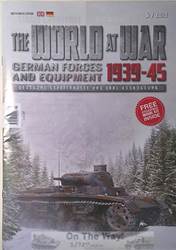 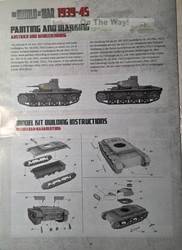 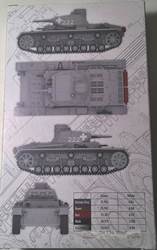
In the box, there are six sprues of parts and a set of decals.
 
Once liberated from the sprues, there are only 26 parts for the kit.
Note that the kits in this line are "Easy-Build" kits, similar
to those made by HaT/Armourfast, Italeri, Pegasus, S-Models, or the
old Eidai/Grip kits. One aspect of these kits is that the entire suspension
(tracks, drive sprockets, idlers, return rollers, running wheels)
are molded as a single piece. Detail is pretty good, but shallow in
some places due to the simplified molding (for example, there is no
detail on the faces of the track links).
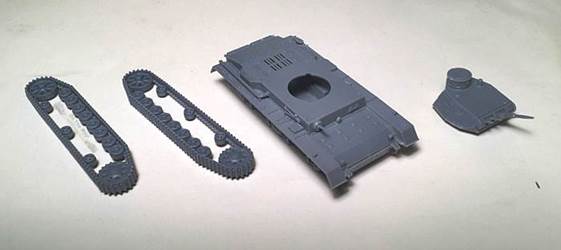
Assembly is pretty simple and straightforward (only four steps in
the instructions). I only had a few points to make:
1. After detaching the lower hull from the sprue, you may have four
prominent flat posts sticking up from the top. These need to be removed
and trimmed flush with the top ledge (at least the rear posts....the
two front ones don't necessarily interfere with assembly).
2. A nice touch is that the bow MG can rotate. The main gun does elevate/depress.
3. The track assemblies do not need to be glued on, just pressed onto
the stubs that receive the drive sprockets and idlers. But if you
do glue them on, don't waste glue on the return roller stubs...they
are not tall enough to actually touch the return rollers.
I completed this kit pretty much out-of-the-box, without any modifications.
After assembly, it's just a painting/detailing project. I chose the
Panzergrau color scheme in the instructions. Some of the softer details
may get obscured by paint (for example, there are two round hatches
on the front lower glacis plate; after a coat of paint I could not
see the hatch outlines anymore).
Two sets of decals for the same vehicle are included; one in white
lettering (used in the opening stages of the battles in Poland), the
other in yellow. Tank crews found out the hard way that the white
crosses on the turrets offered excellent aiming-points for the Polish
anti-tank gunners, and some units repainted the markings in yellow
paint to reduce visibility.
The decals are two crosses and three sets of the vehicle number; instructions
show the placement of the crosses and numbers on the turret sides.
The third number could be placed on the turret rear (although this
was usually a smaller font than on the turret sides)....your choice.
I decided to use the white decals, but dabbed mud-color on the crosses
(an initial fix employed by some crews).
Note that the box and magazine cover art appear to show a vehicle
in Normandy with the later style Balkenkreuz markings; the vehicles
sent to this theater were modified Ausf. B/D vehicles, and no decals
are supplied for this version. The box art also shows the two tone
grey/brown scheme used before the war. Some sources claim this scheme
was used in Poland, but it is not clear to what extent it was employed.
[Ed. Note: According to Panzer
Facts, this scheme was actually the official one until 31 July
1940.]
Overall,
I think this is a nice simple kit of an obscure vehicle for which
there is no alternative model in this scale. Collectors and fans of
Polish campaign dioramas may want one, but hard core detailers may
want to wait to see if IBG or any other manufacturers will offer the
Pz.Kpfw. III Ausf. B in a more detailed kit.
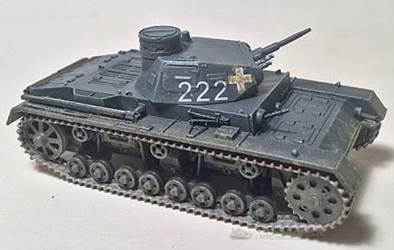 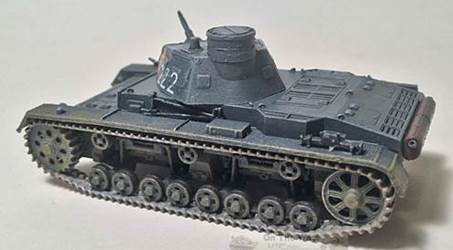
World
at War kits can be purchased from

|